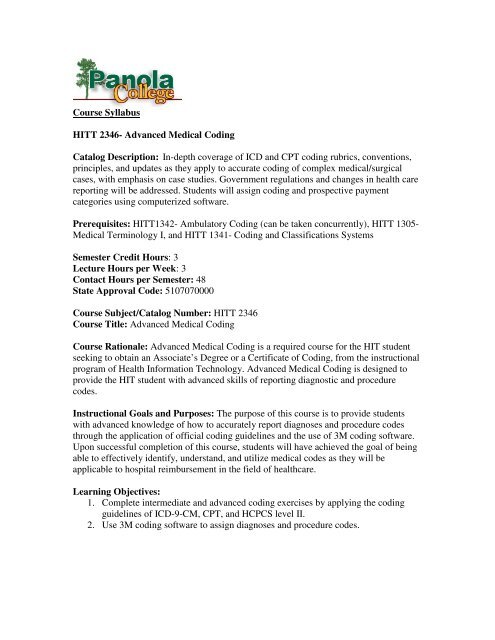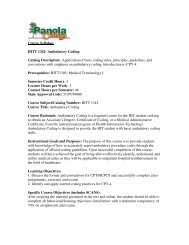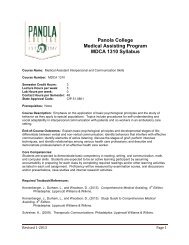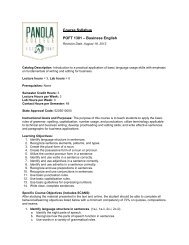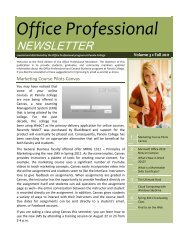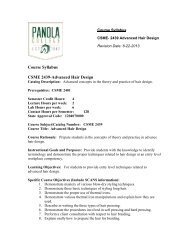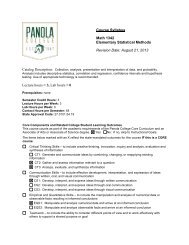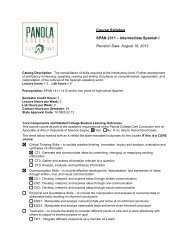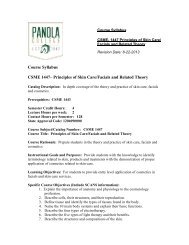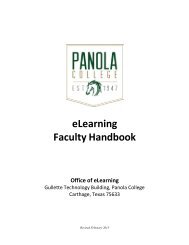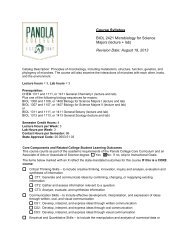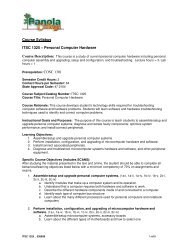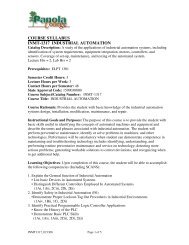Course Syllabus HITT 2346- Advanced Medical ... - Panola College
Course Syllabus HITT 2346- Advanced Medical ... - Panola College
Course Syllabus HITT 2346- Advanced Medical ... - Panola College
Create successful ePaper yourself
Turn your PDF publications into a flip-book with our unique Google optimized e-Paper software.
<strong>Course</strong> <strong>Syllabus</strong><br />
<strong>HITT</strong> <strong>2346</strong>- <strong>Advanced</strong> <strong>Medical</strong> Coding<br />
Catalog Description: In-depth coverage of ICD and CPT coding rubrics, conventions,<br />
principles, and updates as they apply to accurate coding of complex medical/surgical<br />
cases, with emphasis on case studies. Government regulations and changes in health care<br />
reporting will be addressed. Students will assign coding and prospective payment<br />
categories using computerized software.<br />
Prerequisites: <strong>HITT</strong>1342- Ambulatory Coding (can be taken concurrently), <strong>HITT</strong> 1305-<br />
<strong>Medical</strong> Terminology I, and <strong>HITT</strong> 1341- Coding and Classifications Systems<br />
Semester Credit Hours: 3<br />
Lecture Hours per Week: 3<br />
Contact Hours per Semester: 48<br />
State Approval Code: 5107070000<br />
<strong>Course</strong> Subject/Catalog Number: <strong>HITT</strong> <strong>2346</strong><br />
<strong>Course</strong> Title: <strong>Advanced</strong> <strong>Medical</strong> Coding<br />
<strong>Course</strong> Rationale: <strong>Advanced</strong> <strong>Medical</strong> Coding is a required course for the HIT student<br />
seeking to obtain an Associate’s Degree or a Certificate of Coding, from the instructional<br />
program of Health Information Technology. <strong>Advanced</strong> <strong>Medical</strong> Coding is designed to<br />
provide the HIT student with advanced skills of reporting diagnostic and procedure<br />
codes.<br />
Instructional Goals and Purposes: The purpose of this course is to provide students<br />
with advanced knowledge of how to accurately report diagnoses and procedure codes<br />
through the application of official coding guidelines and the use of 3M coding software.<br />
Upon successful completion of this course, students will have achieved the goal of being<br />
able to effectively identify, understand, and utilize medical codes as they will be<br />
applicable to hospital reimbursement in the field of healthcare.<br />
Learning Objectives:<br />
1. Complete intermediate and advanced coding exercises by applying the coding<br />
guidelines of ICD-9-CM, CPT, and HCPCS level II.<br />
2. Use 3M coding software to assign diagnoses and procedure codes.
Specific <strong>Course</strong> Objectives (includes SCANS):<br />
After studying the material presented in the text and online, the student should be able to<br />
complete all behavioral/learning objectives listed below with a minimum competency of<br />
70% on assignments and exams.<br />
1. Complete intermediate and advanced coding exercises by applying the<br />
coding guidelines of ICD-9-CM, CPT, and HCPCS level II. (SCANS 1a-iv.<br />
1a-v. 1bi. 1b-ii. 1b-iii. 1b-iv. 1b-v. 1c-i. 1c-ii. 1c-iii. 1c-iv. 1c-v. 2a-i. 2a-iii. 2b-i.<br />
2b-ii. 2b-iv. 2b-vi. 2c-i. 2c-ii. 2c-iii. 2c-iv.)<br />
i. Identify the characteristics and conventions of ICD-9CM and CPT<br />
through the application of class exercises and exams.<br />
ii. Differentiate between disease specific and organ specific coding<br />
guidelines.<br />
iii. Discuss the current CPT organization, structure, and guidelines.<br />
iv. Utilize the principles of ICD-9, CPT, and HCPCS to complete<br />
intermediate physician-based case study coding exercises.<br />
v. Utilize the principles of ICD-9, CPT, and HCPCS to complete<br />
advanced inpatient case study coding exercises.<br />
vi. Utilize the principles of ICD-9, CPT, and HCPCS to complete<br />
advanced ambulatory case study coding exercises.<br />
vii. Utilize the principles of ICD-9, CPT, and HCPCS to complete<br />
advanced physician-based case study coding exercises.<br />
2. Use 3M coding software to assign diagnoses and procedure codes. (SCANS<br />
1a-iv. 1a-v. 1bi. 1b-ii. 1b-iii. 1b-iv. 1b-v. 1c-i. 1c-ii. 1c-iii. 1c-iv. 1c-v. 2a-i. 2a-iii.<br />
2b-i. 2b-ii. 2b-iv. 2b-vi. 2c-i. 2c-ii. 2c-iii. 2c-iv.)<br />
i. Complete case studies and coding exercises with the use of 3M coding<br />
software.<br />
<strong>Course</strong> Content:<br />
Students in all sections of <strong>Advanced</strong> <strong>Medical</strong> Coding will be required to do the<br />
following:<br />
1. Students will demonstrate knowledge of course material by completing course<br />
examinations given over lecture and textbook material.<br />
2. Students will complete all daily assignments as instructed.<br />
Methods of Instruction/<strong>Course</strong> Format/Delivery:<br />
Students will meet regularly for lecture over the material. Additionally, students will<br />
meet regularly for the laboratory portion of this course. The student is expected to attend<br />
all face-to-face class meetings and all laboratory meetings, of those in which the student<br />
is enrolled. The resources provided, for this class, through WebCT include:<br />
* A calendar displaying assignments each week (assignments will also be given in class)<br />
* Email (totally contained within WebCT)<br />
* Extra credit opportunities
Assignments will not be accepted via WebCT. The assignments are only listed on the<br />
calendar as a reminder. However, after the assignment has been graded by the instructor,<br />
the student will be able to view his or her grades by clicking the My Grades link in the<br />
left banner.<br />
Students should use the Email within WebCT to communicate with the instructor. Using<br />
WebCT email gives you access to the instructor and other classmates without having to<br />
remember or type email addresses- you must select a name from the list. If you are not<br />
able to contact me using email in WebCT, you may use my <strong>Panola</strong> <strong>College</strong> email<br />
address, contact me by telephone, or stop by my office. I attempt to respond to all email<br />
within 24 hours. Please always include a subject line and your name in your email.<br />
Attendance Policy: This class will meet twice each week, for a period of 110 minutes<br />
each session. Attendance will be checked and recorded in the instructor’s grade book at<br />
each class meeting. A maximum of three days of absence will be allowed. If a student is<br />
absent more than three days, they may be dropped from the class (see <strong>Panola</strong> <strong>College</strong><br />
Catalog). In the event the student is not dropped from the class roster due to excessive<br />
absenteeism, the instructor may give the student a letter-grade decrease for every day<br />
absent.<br />
Students are responsible for all assignments, even in the event of an absence. Late tests<br />
and assignments may result in a lowered grade.<br />
Students are encouraged to please be on time for all class sessions. Late arrivals result in<br />
class disruptions. If students arrive late (less than a quarter hour, 15 minutes) they will be<br />
recorded as tardy. Three times of tardy will equal one absence. Additionally, leaving<br />
class early without the instructor’s permission will be recorded as one absence.<br />
Note: Withdrawing from this course is the student’s responsibility. Students who<br />
fail to officially withdraw by notifying the Records and Admission Office will<br />
receive the grade of “F” in the class. Refer to the <strong>College</strong> Calendar for the<br />
official Last Day to Withdraw.<br />
Make-Up Exams: Make-up exams will be allowed if the student has an approved<br />
absence. Exams must be made up within 1 week of the missed exam. The exam may<br />
differ in format from the original exam. Time provided to take make-up exams will not<br />
exceed the time allowed for test during a regular class session (i.e. if the class session is<br />
75 minutes, the student will have 75 minutes to take the make-up exam).<br />
Academic Integrity: Academic misconduct will not be tolerated. Any incident of<br />
academic misconduct will result in a failing grade for the test or assignment.<br />
Classroom Etiquette: All cell phones should be turned off prior to entering the<br />
classroom. Additionally, students are expected to display tolerance for other’s views<br />
during classroom discussions. Comments and language used should be appropriate for a<br />
professional setting.
Assessment:<br />
The following items will be assigned during the semester and used to calculate the<br />
student’s final grade:<br />
* Daily Assignments and Participation<br />
You will be assigned daily assignments that you must complete. All assignments are due<br />
by the scheduled due date. No late work will be accepted.<br />
Additionally, you will be assessed according to your class participation. Class<br />
participation is crucial to a thorough understanding of the material presented.<br />
* Class Project<br />
Students must correctly assign ICD-9-CM diagnoses and procedure codes to inpatient<br />
and ambulatory health records, using 3M coding software. Students must apply all coding<br />
conventions and guidelines that are applicable to the records. The records will be<br />
provided to you by the instructor. This project must be completed in the presence of the<br />
instructor and individual times will be set for groups of students, to allow for completion<br />
of the project.<br />
Exams<br />
You will be required to demonstrate what you have learned by completing course<br />
examinations. In addition to the regular examinations that you will receive throughout the<br />
course, you will be required to complete a comprehensive final examination.<br />
<strong>Course</strong> Grade:<br />
Computation<br />
Class Project 25%<br />
Regular Examinations 25%<br />
Daily assignments and participation 30%<br />
Final Examination 20%<br />
A= 90- 100<br />
B= 80- 89<br />
C= 70- 79<br />
D= 60- 69<br />
F= Below 60<br />
All of your grades will be posted to My Grades in WebCT. Additionally, your midterm<br />
grade and final grade will be posted to My Grades in WebCT.
Textbooks (required):<br />
Clinical Coding Workout without Answers, American Health Information<br />
Management Association, current edition.<br />
Other Materials (recommended):<br />
ICD-9-CM for Hospitals, Vols. 1, 2, & 3, PMIC or AMA. Available edition.<br />
CPT 2007 Professional Edition. American <strong>Medical</strong> Association. Current Edition,<br />
Current Copyright.<br />
If any student in the class has special classroom or testing needs because of a physical, learning or<br />
emotional condition, please contact Teresa Washington-Shelby, ADA Student Coordinator, in the<br />
Martha Miller Administration Building @ (903) 693-1123.
Secretary of Labor’s Commission on Achieving Necessary Skills (SCANS)<br />
<strong>HITT</strong> <strong>2346</strong>- <strong>Advanced</strong> <strong>Medical</strong> Coding<br />
I. BASIC SKILL COMPETENCIES<br />
A. Basic Skills<br />
i. Reading: Locate, understand and interpret written information in prose and in documents such as<br />
manuals, graphs and schedules.<br />
ii. Writing: Communicate thoughts, ideas, information and messages in writing, and create documents<br />
such as letters, directions, manuals, reports, graphs, and flow charts<br />
iii. Arithmetic & Mathematical Operations: Perform basic computations and approach practical<br />
problems by choosing appropriately from a variety of mathematical techniques.<br />
iv. Listening: Receive, attend to, interpret, and respond to verbal messages and other cues.<br />
v. Speaking: Organize ideas and communicate orally.<br />
B. Thinking Skills<br />
i. Creative Thinking: Generate new ideas.<br />
ii. Decision Making: Specify goals and constraints, generate alternatives, consider risks and evaluate<br />
and choose the best alternative.<br />
iii. Problem Solving: Recognize problems and devise and implement plan of action.<br />
iv. Visualize ("Seeing Things in the Mind's Eye"): Organize and process symbols, pictures, graphs,<br />
objects, and other information.<br />
v. Reasoning: Discover a rule or principle underlying the relationship between two or more objects<br />
and apply it when solving a problem.<br />
C. Personal Qualities<br />
i. Responsibility: Exert a high level of effort and persevere toward goal attainment.<br />
ii. Self-Esteem: Believe in one's own self-worth and maintain a positive view of oneself.<br />
iii. Sociability: Demonstrate understanding, friendliness, adaptability, empathy, and politeness in<br />
group settings.<br />
iv. Self-Management: Assess oneself, set personal goals, monitor progress, and exhibit self-control.<br />
v. Integrity & Honesty: Choose ethical courses of action.<br />
II. WORKPLACE COMPETENCIES<br />
A. Resources:<br />
i. Time: Select goal-relevant activities, rank them, allocate time, and prepare and follow schedules.<br />
ii. Money: Use or prepare budgets, make forecasts, keep records, and make adjustments to meet<br />
objectives.<br />
iii. Material & Facilities: Acquire, store, allocate, and use materials or space efficiently.<br />
iv. Human Resources: Assess skills and distribute work accordingly, evaluate performance and<br />
provide feedback.<br />
B. Interpersonal Skills:<br />
i. Participate as Member of a Team: Contribute to group effort.<br />
ii. Teach Others New Skills.<br />
iii. Serve Clients/ Customers: Work to satisfy customers' expectations.<br />
iv. Exercise Leadership: Communicate ideas to justify position, persuade & convince others,<br />
responsibly challenge existing procedures & policies.<br />
v. Negotiate: Work toward agreements involving exchange of resources, resolve divergent interests.<br />
vi. Work with Diversity: Work well with men and women from diverse backgrounds.<br />
C. Information:<br />
i. Acquire and Evaluate Information.<br />
ii. Organize and Maintain Information.<br />
iii. Interpret and Communicate Information.
iv. Use computers to process information.<br />
D. Systems:<br />
i. Understand Systems: Know how social, organizational and technological systems work and operate<br />
effectively with them.<br />
ii. Monitor & Correct Performance: Distinguish trends, predict impacts on system operations,<br />
diagnose deviations in systems' performance<br />
iii. Improve or Design Systems: Suggest modifications to existing systems and develop new or<br />
alternative systems to improve performance.


